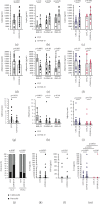Discriminatory Value of Adiponectin to Leptin Ratio for COVID-19 Pneumonia
- PMID: 35529082
- PMCID: PMC9072020
- DOI: 10.1155/2022/9908450
Discriminatory Value of Adiponectin to Leptin Ratio for COVID-19 Pneumonia
Abstract
Purpose: Obesity is a risk factor for severe coronavirus disease 2019 (COVID-19). Circulating adipokines have been associated with inflammatory burden and amplified or dysregulated immune responses. This study aimed to evaluate the discriminatory ability of adipokines to identify COVID-19 pneumonia and to assess disease severity.
Methods: We conducted an observational case-control study, with a prospective design, and recruited patients with diagnosis of COVID-19 pneumonia (n = 48) and healthy controls (n = 36), who were matched by age, sex, and BMI. Leptin, adiponectin, IL-6, and TNF-α were measured by ELISA.
Results: Patients with COVID-19 pneumonia had higher levels of leptin, lower adiponectin/leptin (Adpn/Lep) ratio, and higher expression of IL-6. Leptin had an acceptable discriminatory accuracy for COVID-19 pneumonia in patients with BMI >30 (AUC 0.74 [0.58, 0.90]) with a cutoff of 7852 pg/mL and it was associated with maximum respiratory support. By contrast, Adpn/Lep had an excellent discriminatory accuracy for COVID-19 pneumonia in patients with BMI <25 (AUC 0.9 [0.74, 1.06]) with a cutoff of 2.23.
Conclusion: Our data indicate that high Adpn/Lep (>2.23) in lean patients is consistent with a state of good health, which decreases in case of inflammatory states, ranging from adipose tissue dysfunction with low-grade inflammation to COVID-19 pneumonia.
Copyright © 2022 Federica Tonon et al.
Conflict of interest statement
The authors declare that there are no conflicts of interest regarding the publication of this article.
Figures



References
-
- Palaiodimos L., Kokkinidis D. G., Li W., et al. Severe obesity, increasing age and male sex are independently associated with worse in-hospital outcomes, and higher in-hospital mortality, in a cohort of patients with COVID-19 in the Bronx, New York. Metabolism . 2020;108 doi: 10.1016/j.metabol.2020.154262.154262 - DOI - PMC - PubMed
LinkOut - more resources
Full Text Sources
Miscellaneous

